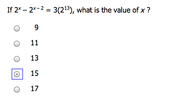Hi EricImasogie,
Factoring the equation (as Brent showed) is a useful approach here. You can actually take it a step further by TESTing THE ANSWERS (you might find it easier to manipulate numbers than to manipulate variables). One of those numbers IS the value of X, so you can plug them in, do the necessary math and find the one value that balances out the equation. Here's how to approach it:
Since the "right side" of the equation is greater than 2^14, X must be bigger than 14 (since the "left side" of the equation involves subtraction). So we can eliminate A, B and C.
Let's TEST answer D: 15
If X = 15, then...
2^15 - 2^13 can be factored into...
(2^13)(2^2 - 1) =
(2^13)(3)
This is EXACTLY what's on the "right side" of the equation, so X MUST be 15
Final Answer: D
GMAT assassins aren't born, they're made,
Rich

